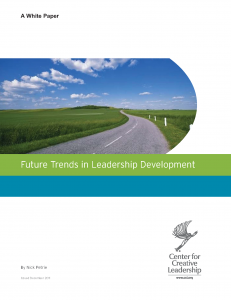 Nick Petrie (December 2011). Future Trends in Leadership Development: A White Paper. Greensborough, North Carolina: Center for Creative Leadership.
Nick Petrie (December 2011). Future Trends in Leadership Development: A White Paper. Greensborough, North Carolina: Center for Creative Leadership.
Many of the ideas associated with integral leadership are beginning to show up in the mainstream business and organizational literature. Note, for example, the leader-follower-context model of Barbara Kellerman discussed in Russ Volckmann’s interview with her in this issue (June 2012) of Integral Leadership Review and Kellerman’s book, The End of Leadership. This white paper is another solid example.
While constrained by the lack of a meta model such as integral, Nick Petrie analysis of what has been and is becoming in leader and leadership development is comprehensive and connected to many variables that an integral perspective would bring. These include
(1) Attention to growing complexity and change,
(2) Implications for shifting from heroic notions of the leadcr to collective leadership (which is not to say that most of those in the integral leadership industry have gotten to that, yet),
(3) The need to shift from event-driven competency development to ongoing self-guided and self-authoring processes that are long term.
Petrie’s presentation is heavily influenced by the work of Robert Kegan and Bill Torbert, for example, in bringing an adult development perspective to the challenges of leading and leadership in organizations. As is the case in much of the relevant literature the focus is on large complex organizations. After all, this is where a lot of the leadership development money is. This is not to say that Petrie has no other perspective, but that his valuable insights do not include the implications of varying sized organizations, other than recognizing that individual and collective development will include different elements at the individual, team, organization, network and systems levels. This framework is drawn principally from the Bertelsmann Stiftung Leadership Development model. These are useful categories, but they are not mutually exclusive. Still, it is a step forward from assuming all contexts can be blended into one notion of what is required for effective leading.
I particularly liked Petrie’s attention to our need to shift the way we think about leadership. Unfortunately, aside from the leader-leadership (individual-collective) distinction this is not extended explicitly to leading (although there is much that is relevant to that, particularly as a stage development process). Further, there is no useful distinction made between the manager and leader roles, although it is clear in the paper that who leads can be situated in many places in the various levels of organizations. We have much to learn about how true this is, particularly in relationship to the organization as a whole and in its systemic context.
This, too, is a valuable feature of Petrie’s work. It is not replete with solutions, but points toward potentials. The solutions will be driven by many variables, far too many for the role of the heroic leader to be more than a snapshot (albeit occasionally critical) in the life of a system.
There were four trends for the future of leadership development identified by Petrie. The first will be of particular interest to those interested in integral approaches and adult development: “More focus on vertical development.” The other three are important, as well:
• “Transfer of greater developmental ownership to the individual,”
• “Greater focus on collective rather than individual leadership,” and
• “Much greater focus on innovation in leadership development methods”.
These involve a major shift away from the competency based leader development programs towards lifelong learning in
• Adaptability
• Self-awareness
• Boundary spanning
• Collaboration
• Network thinking
So if you are looking for signs that the world of organizations and development are opening to integral perspectives and ideas, here is a good place to start. And, as Petrie would no doubt agree, we still have much to learn.
